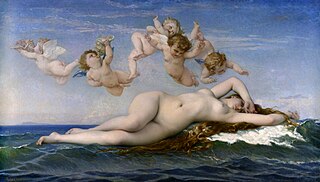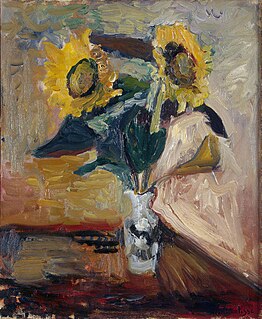
Painterliness is a concept based on the German term malerisch (painterly), a word popularized by Swiss art historian Heinrich Wölfflin (1864–1945) to help focus, enrich and standardize the terms being used by art historians of his time to characterize works of art. It is the opposite of linear, plastic or formal linear design.

In Zen, ensō is a circle that is hand-drawn in one or two uninhibited brushstrokes to express a moment when the mind is free to let the body create.
A hallmark is an official mark or series of marks struck on items made of metal, mostly to certify the content of noble metals—such as platinum, gold, silver and in some nations, palladium. In a more general sense, the term hallmark can also be used to refer to any distinguishing characteristic.
A cel, short for celluloid, is a transparent sheet on which objects are drawn or painted for traditional, hand-drawn animation. Actual celluloid was used during the first half of the 20th century, but since it was flammable and dimensionally unstable it was largely replaced by cellulose acetate. With the advent of computer-assisted animation production, the use of cels has been all but abandoned in major productions. Disney studios stopped using cels in 1990 when Computer Animation Production System (CAPS) replaced this element in their animation process, and in the next decade and a half, the other major animation studios phased cels out as well.

Luminism is an American landscape painting style of the 1850s to 1870s, characterized by effects of light in landscape, through the use of aerial perspective and the concealment of visible brushstrokes. Luminist landscapes emphasize tranquility, and often depict calm, reflective water and a soft, hazy sky. Artists who were most central to the development of the luminist style include Fitz Hugh Lane, Martin Johnson Heade, Sanford Gifford, and John F. Kensett. Painters with a less clear affiliation include Frederic Edwin Church, Jasper Cropsey, Albert Bierstadt, Worthington Whittredge, Raymond Dabb Yelland, Alfred Thompson Bricher, James Augustus Suydam, and David Johnson. Some precursor artists are George Harvey and Robert Salmon.

The Death of Sardanapalus is an oil painting on canvas by Eugène Delacroix, dated 1827. It currently hangs in the Musée du Louvre, Paris. A smaller replica, painted by Delacroix in 1844, is now in the Philadelphia Museum of Art.

The École du Louvre is an institution of higher education located in the Aile de Flore of the Louvre Palace in Paris, France. It is dedicated to the study of archaeology, art history, anthropology and epigraphy.
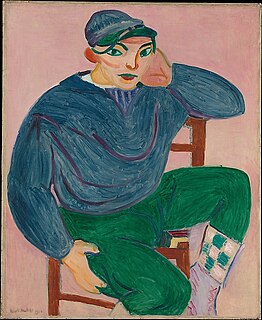
The Young Sailor II is a painting by Henri Matisse from 1906. It is in the collection of the Metropolitan Museum of Art, New York.

Young Girl Reading, or The Reader, is an 18th-century oil painting by Jean-Honoré Fragonard. It was purchased by the National Gallery of Art in Washington, DC in 1961 using funds donated by Ailsa Mellon Bruce, the daughter of Andrew W. Mellon, following her father's death. Alisa Mellon Bruce was a well-known socialite in Manhattan and gained recognition in the art world from the numerous generous donations she gave to a variety of museums and art programs.

Little Big Painting is a 1965 oil and Magna on canvas pop art painting by Roy Lichtenstein. It is part of the Brushstrokes series of artworks that include several paintings and sculptures. It is located at the Whitney Museum of American Art in New York City. As with all of his Brushstrokes works, it is in part a satirical response to the gestural painting of abstract expressionism.

Women in the Garden is an oil painting begun in 1866 by French artist Claude Monet when he was 26. It is a large work painted en plein air; the size of the canvas necessitated Monet painting its upper half with the canvas lowered into a trench he had dug, so that he could maintain a single point of view for the entire work. The setting is the garden of a property he was renting. His companion Camille posed for the figures. Monet finished the work indoors, and used magazine illustrations to render fashionable clothing.

House in Provence is an oil painting by French artist Paul Cézanne. Created in 1885, it is currently part of the permanent collection in the Indianapolis Museum of Art.

Big Painting No. 6 is a 1965 oil and Magna on canvas painting by Roy Lichtenstein. Measuring 235 cm × 330 cm, it is part of the Brushstrokes series of artworks that includes several paintings and sculptures whose subject is the actions made with a house-painter's brush. It set a record auction price for a painting by a living American artist when it sold for $75,000 in 1970. The painting is in the Kunstsammlung Nordrhein-Westfalen collection.
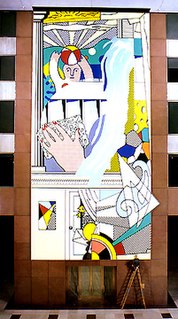
Mural with Blue Brushstroke is a 1986 mural painting by Roy Lichtenstein that is located in the atrium of the Equitable Tower in New York City. The mural was the subject of the book Roy Lichtenstein: Mural With Blue Brushstroke. The mural includes highlights of Lichtenstein's earlier works.
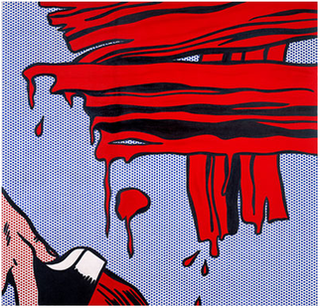
Brushstrokes series is the name for a series of paintings produced in 1965–66 by Roy Lichtenstein. It also refers to derivative sculptural representations of these paintings that were first made in the 1980s. In the series, the theme is art as a subject, but rather than reproduce masterpieces as he had starting in 1962, Lichtenstein depicted the gestural expressions of the painting brushstroke itself. The works in this series are linked to those produced by artists who use the gestural painting style of abstract expressionism made famous by Jackson Pollock, but differ from them due to their mechanically produced appearance. The series is considered a satire or parody of gestural painting by both Lichtenstein and his critics. After 1966, Lichtenstein incorporated this series into later motifs and themes of his work.

Brushstrokes is a 1965 oil and Magna on canvas pop art painting by Roy Lichtenstein. It is the first element of the Brushstrokes series of artworks that includes several paintings and sculptures. As with all of his Brushstrokes works, it is in part a satirical response to the gestural painting of Abstract Expressionism.

Cliff Rock - Appledore is an oil painting by American artist Childe Hassam, painted in 1903. It is currently part of the permanent collection at the Indianapolis Museum of Art.

Afternoon Tea is a 1910 oil painting by American artist Richard E. Miller, located in the Indianapolis Museum of Art, which is in Indianapolis, Indiana. Like many of Miller's paintings, it depicts women in a sunny scene, filled with flowers, depicted in his Impressionist style with a distinct flavor of Japonism.
e-David is a painting robot developed at the Universität Konstanz that calculates brushstrokes from an input image and paints the image on a canvas. The project began in 2009 as a one-armed welding robot modified to be able to paint. The robot’s arm can interchange between different brushes and pens, and is equipped with a distance sensor to measure exactly how far the arm is from the canvas. e-David features two main painting methods: predefined stroke candidates and dynamically generated strokes.

Plum Park in Kameido is a woodblock print in the ukiyo-e genre by the Japanese artist Hiroshige. It was published in 1857 as the thirtieth print in the One Hundred Famous Views of Edo series and depicts Prunus mume trees in bloom.
